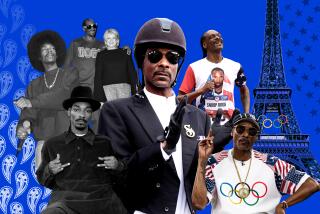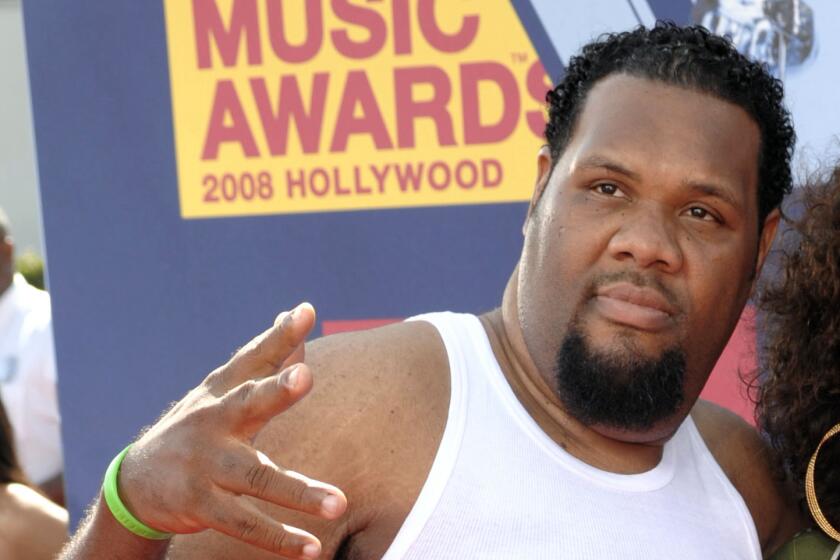Large and In Charge
Ever since it bubbled up from the urban underground two decades ago, the most controversial and flamboyant American pop music since rock ‘n’ roll has gotten a bum rap.
Dismissed by mainstream critics and shunned by radio program directors as a fringe genre, rap music was viewed with derision and outright disdain, particularly by white taste-makers who laughed it off as a passing fad.
But that was then.
Twenty years and tens of millions of record sales later, there’s no disputing that rap has survived--and thrived.
Not only has it irrevocably altered the pop music landscape and become a dominant force on the nation’s sales charts, but it has also spurred a cultural revolution that has pushed the music’s sounds and images into everything from advertising to fashion.
Still, late last year there was renewed skepticism about rap’s commercial and artistic future.
One question: Could rap maintain its stronghold after the murders of two of its biggest and most innovative stars--Tupac Shakur and the Notorious B.I.G.--and the dramatic decline of its most celebrated label, Death Row, after the incarceration of its chairman, Marion “Suge” Knight?
Another concern: Would fans eventually be repelled by the way the music’s violent imagery was being played out on the streets--not to mention the continuing, relentless misogyny?
In retrospect, the questions were probably as naive as the early misgivings about rap’s future. Thanks to a seemingly endless influx of new talent, rap’s sales are up almost a third over last year’s $1.4 billion take, which represented 10% of total U.S. record sales.
And rap shows no signs of abating. Upcoming albums by Snoop Dogg, Timbaland and the Wu-Tang Clan’s Ghostface Killah, and the seemingly endless stream of hit acts tied to rapper and label owner Master P’s No Limit banner (the late-’90s equivalent of Death Row) should keep cash registers humming well into the new year.
“Creatively, hip-hop stagnated a bit when Tupac and Biggie died,” says Jermaine Dupri, an Atlanta-based rap and R&B; producer who recently released his first solo album on his own So-So Def label. “But now, you’ve gotta come up with a really good record to make an impact, ‘cause there’s so much good stuff coming out, and the competition is fierce.”
Where rap once struggled to find acceptance within the mass culture, it has now become a ubiquitous mainstream presence. Whether it’s Busta Rhymes hawking Mountain Dew on a Sunset Strip billboard or Warren Beatty donning gold chains and a knit cap in “Bulworth,” rap has completely infiltrated American media.
“The reality is if you’re not in the rap business, you’re not in the music business,” says Elektra Entertainment Group chairman and CEO Sylvia Rhone, whose roster includes such platinum rap acts as Rhymes and Missy “Misdemeanor” Elliott.
In fact, rap’s influence is so pervasive that it has emerged as the first musical style since the ‘50s to truly rival rock ‘n’ roll as the primary music of choice for American youth culture. It’s already battled rock to a standstill on MTV, where a video by rap producer-turned-solo-artist Sean “Puff Daddy” Combs gets as much airplay as anything from Matchbox 20 or Third Eye Blind. And it’s virtually no contest on the sales charts, where rap albums and singles regularly clog the national Top 10 lists.
Although rap maintains a strong African American base, most rap albums are bought by white fans. According to a recent SoundScan survey, two-thirds of all rap music in 1997 was purchased by white consumers, and nearly 50% of all rap music is purchased by those under 18. Much of that money, retailers say, comes at the expense of rock.
“Urban kids set the trends, then the suburban kids follow en masse,” says Jesse Washington, editor of Blaze, a new hip-hop magazine from the publishers of Spin and Vibe. “Hip-hop’s got more of a lock on youth culture than ever before.”
“The bottom line is, it’s connecting with young people because a lot of it is great stuff,” says Elektra’s Rhone. “It’s not only an art form, but it’s the new rock music for the new millennium.”
One of the most remarkable aspects of rap’s appeal with white suburban mall rats is their appetite for music that plumbs the darkest depths of ghetto life.
Although the loaded term “gangsta rap” has long gone out of style, a variation on that hard-core subgenre is dominating both the pop and rap charts, and it’s mostly coming from one man.
Percy Miller, a.k.a. Master P, isn’t the only bright new star in rap--he shares the spotlight with newcomers such as Wyclef Jean, DMX, Silkk the Shocker, C-Murder, Canibus, Timbaland & Magoo and John Forte.
And Master P hasn’t quite achieved the mainstream recognition of Puff Daddy, currently rap’s biggest crossover superstar (see accompanying story).
But Master P may well be rap’s biggest power player--and kingmaker--of the moment.
Seven years after establishing the New Orleans-based No Limit label as a vehicle for his own solo records, Master P has seen it become rap’s fastest-growing indie enterprise.
By peddling a verbally punishing, graphic brand of rap that draws liberally from ‘80s gangsta rap pioneers N.W.A. as well as more contemporary artists such as Snoop Dogg, Master P’s roster--which includes relatives and childhood friends--has sold more than 20 million albums.
Such is the marketplace supremacy of No Limit that Snoop Dogg, who sold close to 10 million albums with Death Row, bypassed the major labels when he became a free agent last year in order to sign with No Limit. The label will release Snoop’s new album, “Da Game Is to Be Sold, Not to Be Told,” on Aug. 4.
Despite all the hue and cry from anti-rap crusaders about hard-core rap’s inflammatory, prurient lyrical content, and some highly publicized attempts by major labels to distance themselves from the most controversial rap, artists have not felt the need to tone down their lyrics to generate sales.
In fact, the opposite has proven to be true. DMX, whose debut album “It’s Dark and Hell Is Hot” entered the pop album chart at No. 1, sees himself as a kind of heir apparent to Shakur, and projects a suitably roughneck, thuggish persona.
DMX, whose real name is Earl Simmons, was accused last month of raping a woman he met at a strip club in New York. An attorney for the rapper denied the charges and DMX is free on $10,000 bail.
His stark, frequently disturbing imagery falls within the continuum that stretches from N.W.A. to Shakur and New York’s Wu-Tang Clan.
In one song on DMX’s Def Jam album, the language gets as ugly as this: If you got a daughter older than fifteen, I’m a [gonna] rape her / Take her on the living-room floor, right there in fronta you / Then ask you seriously, ‘What you wanna do?’
“There’s nothing about DMX that can be considered a sellout or disingenuous,” says Russell Simmons, chairman and CEO of Rush Communications, which includes pioneering rap label Def Jam. “DMX has never raped anyone, and anybody who looks into it knows it’s ridiculous. He’s got a rap sheet, but he’s a family man. The album is a moral album. It’s about the struggle with God and the devil. I totally stand behind it.”
Because harder-edged rap remains so volatile, many labels have instituted in-house committees that allow them to vet all potentially controversial lyrics and then decide whether they are worthy of public consumption.
At Seagram-owned MCA--home to such brooding, in-your-face rap artists as Killah Priest and GZA and potentially home to DMX if Seagram’s $10.4-billion purchase of PolyGram goes through--two such committees exist.
Composed of various executives and board members, these in-house star chambers have occasionally rejected entire songs outright.
“I’ve had artists do over some songs, or I’ve been forced to take out certain words,” says MCA artists-and-repertoire manager Bilal Allah. “Last summer, I had to do one song over four times. MCA is very hard on lyrical content, and making sure we’re socially responsible.”
So why does MCA still sign hard-core acts if they’re so concerned with public perception? “Part of our job is to stay current with what’s happening,” says Allah. “We all have our own personal tastes, but our job is to give the kids what they want. The DMXs of the world definitely have something to say, but as for all that rape stuff, . . . I don’t even go near that.”
Stretched out in his trailer on the set of his latest straight-to-video film, “Da Last Don,” Master P, 28, is wiped out from a long day of filming, and is practically nodding off in between questions.
While he’s shooting in an abandoned warehouse in downtown L.A., P is also running No Limit’s many-pronged operations via his omnipresent cell phone.
After explaining that “Da Last Don”--both the album and its film tie-in--is his last official act as a solo artist (“I don’t have time to make my own records anymore”), Master P tries to articulate why he has become the rap entrepreneur with the Golden Gut.
“I just make stuff that the average person can relate to,” he says, a black skull cap tightly affixed to his shaved head. “It’s not about specific ‘hoods, which is what so many other rappers have done. It’s universal, ‘cause I’ve seen life from both sides, and I’ve seen what’s gone on in lots of different communities.”
Master P’s ascent was swift.
A native of New Orleans, he grew up in the notorious Calliope projects with his mother and three younger brothers and bore witness to the inner-city horror scenes that later informed his music. His younger brother Kevin was killed by a drug addict in 1990.
Moving to Northern California in search of a safer environment at age 20, he opened a record store in Richmond with $10,000 that his grandmother had received in a wrongful death suit involving her husband.
Within two years, he had gone from selling records to making his own, which he took around to retail shops in his car. Realizing he needed wider reach, he cut a distribution deal with Priority Records, and began calling on friends and relatives to record for him.
Over the last two years, the label has scored million-selling albums from Master P’s younger brothers C-Murder and Silkk the Shocker as well as Mia-X, Mystikal, Fiend, TRU, Mr. Serv-On, and the West Coast Bad Boys.
The entrepreneur has also branched out into films. His first straight-to-video production, 1997’s “I’m ‘Bout It,” was self-financed for $1 million and sold more than 200,000 videocassettes.
No Limit’s first theatrical release, “I Got the Hook-Up,” an urban comedy that stars Master P and other artists on the No Limit roster, grossed over $5 million on its opening weekend in April, a more-than-respectable figure for a film that cost $3.5 million to finance.
“I ain’t trying to make mainstream records,” says P, speaking in an ominous growl. “I’m making the same records I was making five years ago, and that’s why they’re selling. They’re not watered down. Some guys change so they can get a wider market, but if people want to buy my records, they have to accept them for what they are.”
Indeed, Master P makes no concessions to either current musical trends or mainstream marketing techniques. No Limit’s CDs tend to be packaged in crudely designed jewel boxes containing the usual hard-core rap imagery--cars, money, girls. The music--a fusion of West Coast G-funk, Southern R&B; grooves and blunt beats--is raw, uncompromising and garish.
“What Master P has done is simply phenomenal,” says Elektra’s Rhone. “He started out with a grass-roots base, and was able to upgrade to mainstream success in a very short period of time.”
Even if you threw out Master P and the entire hard-core contingent, rap would still be a potent sales force--thanks largely to the artist-producer-record executive who came on the scene in 1991 with the same dramatic impact as Master P did last year: Sean “Puff Daddy” Combs.
After molding the careers of artists such as Jodeci, Mary J. Blige, the Notorious B.I.G. and Faith Evans, Combs struck out on his own as a solo artist in 1996.
“No Way Out,” Puff Daddy’s solo debut, has sold 5 million copies on the strength of some user-friendly samples and sleek, stylish videos for songs such as “Can’t Nobody Hold Me Down” and “It’s All About the Benjamins.” It’s a strategy that many in the hip-hop community have criticized as shameless pandering.
“A lot of people think Puff is cannibalizing rap, but he’s a very good image-maker,” says Blaze magazine’s Washington. “He exhibited that early in his career with Mary J. Blige and Jodeci. Plus, he’s come in and energized the genre by making it danceable again.”
Combs is spearheading a more optimistic brand of rap that emphasizes up-tempo grooves and constructive frivolity. Other artists in this loosely defined category include Timbaland & Magoo, Missy Elliott, Busta Rhymes, Mase and the Fugees’ Wyclef Jean. And even, for better or worse, Will Smith.
Weaned on the seminal party grooves of old-school forerunners such as the Sugarhill Gang and Run-DMC, these artists are trying to reclaim rap as a harmless vehicle for playful, innocent self-expression and spiritual uplift. In many ways, it’s the necessary corollary to No Limit’s R-rated rants.
“To me, rap is kinda stuck,” says Elliott. “Everything on the radio sounds the same, and the world follows radio. That’s why I’m trying to do something different, to make it something new. There’s too much negativity in rap now. I’m trying to make it a more positive thing.”
The anti-hard-core rap of Elliott and other like-minded artists is gradually starting to jockey for position with the No Limit crew on the charts, further ratcheting up rap’s market share and expanding its aesthetic parameters.
For the moment, however, it’s Master P who wears the crown in rap, and his success underscores the regional explosion in a field whose artists once came almost exclusively from New York and Los Angeles.
Rap’s new geographic and stylistic diversity has only strengthened its chart dominance. Recent best-selling acts have run the gamut from Portsmouth, Va.’s Elliott, whose album “Supa Dupa Fly” injected a shot of playful irreverence into the genre, to Atlanta’s Goodie Mob, a quartet whose reflective urban sermons on the album “Still Standing” have resonated with listeners and critics alike.
“I love the diversity in rap now,” says Russell Simmons. “I love that Master P can come in and bring that new energy to rap. People talk about rappers competing for market share, but there’s still a lot of room for growth. Everybody learns from it, and it makes the music better.”
Although rap primarily remains the province of male performers, women also are slowly making inroads. The two biggest stars, Elliott and the Fugees’ Lauryn Hill, cater to a crossover crowd that ignores the genre’s more extremist strain in favor of hip-hop hybrids that combine rap with elements of R&B; and pop. The trio Salt-N-Pepa also represents rap’s pop side.
At the other end of the spectrum are artists such as Lil’ Kim and Foxy Brown, who combine personas that play into hard-core rap’s cartoonish sex-bomb stereotypes with a sexually aggressive lyrical approach. Aside from them and ‘80s veteran MC Lyte, who continues to command a loyal fan base, rap remains a man’s world.
“As more women move up on the corporate ladder, more female rappers will get signed,” says Blaze’s Washington. “And more of them are gonna get by on talent, not because they’re sex symbols.”
The rags-to-riches stories of all these rappers have not been lost on young rap fans who also dream of stardom. Indeed, some record executives talk about a talent explosion the likes of which pop music hasn’t felt since the early days of rock.
“With a few exceptions in rock music today, most of the spirit that we all felt in the mid-’60s and early ‘70s from rock ‘n’ roll is now being delivered by young hip-hop artists and producers,” says Jimmy Iovine, the co-founder of Interscope Records, who has worked as engineer or producer with such artists as John Lennon, Bruce Springsteen and U2. “So it’s only natural that audiences are responding to that. We have in the ‘90s seen a fundamental shift in the direction of popular music.”
Whether or not rap replaces rock as the dominant musical voice of young America, other executives also see a bright future for the music.
“Twenty years ago, they asked me if rap had a future, because people thought it was a joke,” says Rush’s Russell Simmons, who released the first records by Run-DMC, the Beastie Boys and LL Cool J in the mid-’80s. “But the idea that it’s a novelty is over. We haven’t sold out to become mainstream--the mainstream has come to us.
“But the great thing is, the old folks still think of it as dangerous, which only makes it more appealing to youth culture. As long as we continue to meet resistance from the cultural gatekeepers, rap will survive.”
More to Read
The biggest entertainment stories
Get our big stories about Hollywood, film, television, music, arts, culture and more right in your inbox as soon as they publish.
You may occasionally receive promotional content from the Los Angeles Times.










